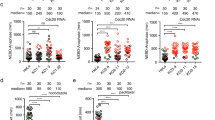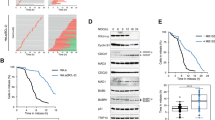Abstract
Cells divide with remarkable fidelity, allowing complex organisms to develop and possess longevity. Checkpoint controls contribute by ensuring that genome duplication and segregation occur without error so that genomic instability, associated with developmental abnormalities and a hallmark of most human cancers1,2,3,4,5, is avoided. S-phase checkpoints prevent cell division while DNA is replicating6,7,8. Budding yeast Mec1p and Rad53p, homologues of human checkpoint kinases ATM/ATR and Chk2, are needed for this control system. How Mec1p and Rad53p prevent mitosis in S phase is not known. Here we provide evidence that budding yeasts avoid mitosis during S phase by regulating the anaphase-promoting complex (APC) specificity factor Cdc20p: Mec1p and Rad53p repress the accumulation of Cdc20p in S phase. Because precocious Cdc20p accumulation causes anaphase onset and aneuploidy, Cdc20p concentrations must be precisely regulated during each and every cell cycle. Catastrophic mitosis induced by Cdc20p in S phase occurs even in the absence of core APC components. Thus, Cdc20p can function independently of the APC.
This is a preview of subscription content, access via your institution
Access options
Subscribe to this journal
Receive 12 print issues and online access
$209.00 per year
only $17.42 per issue
Buy this article
- Purchase on Springer Link
- Instant access to full article PDF
Prices may be subject to local taxes which are calculated during checkout





Similar content being viewed by others
References
Kolodner, R. Biochemistry and genetics of eukaryotic mismatch repair. Genes Dev. 10, 1433–1442 (1996).
Jiricny, J. Replication errors: cha(lle)nging the genome. EMBO J. 17, 6427–6436 (1998).
Lengauer, C., Kinzler, K.W. & Vogelstein, B. Genetic instabilities in human cancers. Nature 396, 643–649 (1998).
Kinzler, K.W. & Vogelstein, B. Landscaping the cancer terrain. Science 280, 1036–1037 (1998).
Tsongalis, G.J. & Coleman, W.B. Molecular oncology: diagnostic and prognostic assessment of human cancers in the clinical laboratory. Cancer Invest. 16, 485–502 (1998).
Weinert, T.A., Kiser, G.L. & Hartwell, L.H. Mitotic checkpoint genes in budding yeast and the dependence of mitosis on DNA replication and repair. Genes Dev. 8, 652–665 (1994).
Allen, J.B., Zhou, Z., Siede, W., Friedberg, E.C. & Elledge, S.J. The SAD1/RAD53 protein kinase controls multiple checkpoints and DNA damage-induced transcription in yeast. Genes Dev. 8, 2401–2415 (1994).
Clarke, D.J., Segal, M., Mondesert, G. & Reed, S.I. The Pds1 anaphase inhibitor and Mec1 kinase define distinct checkpoints coupling S phase with mitosis in budding yeast. Curr. Biol. 9, 365–368 (1999).
Clarke, D.J., Segal, M., Jensen, S. & Reed, S.I. Mec1p regulates Pds1p levels in S phase: complex coordination of DNA replication and mitosis. Nature Cell Biol. 3, 619–627 (2001).
Yamamoto, A., Guacci, V. & Koshland, D. Pds1p, an inhibitor of anaphase in budding yeast, plays a critical role in the APC and checkpoint pathway(s). J. Cell Biol. 133, 99–110 (1996).
Shirayama, M., Zachariae, W., Ciosk, R. & Nasmyth, K. The Polo-like kinase Cdc5p and the WD-repeat protein Cdc20p/fizzy are regulators and substrates of the anaphase promoting complex in Saccharomyces cerevisiae. EMBO J. 17, 1336–1349 (1998).
Clarke, D.J. et al. Dosage suppressors of pds1 implicate UBA domains in checkpoint control. Mol. Cell. Biol. 21, 1997–2007 (2001).
Prinz, S., Hwang, E.S., Visintin, R. & Amon, A. The regulation of Cdc20 proteolysis reveals a role for APC components Cdc23 and Cdc27 during S phase and early mitosis. Curr. Biol. 8, 750–760 (1998).
Hwang, L.H. et al. Budding yeast Cdc20: a target of the spindle checkpoint. Science 279, 1041–1044 (1998).
Peters, J.M. The anaphase-promoting complex: proteolysis in mitosis and beyond. Mol. Cell 9, 931–943 (2002).
Kramer, K.M., Fesquet, D., Johnson, A.L. & Johnston, L.H. Budding yeast RSI1/APC2, a novel gene necessary for initiation of anaphase, encodes an APC subunit. EMBO J. 17, 498–506 (1998).
Lim, H.H. & Surana, U. Cdc20, a beta-transducin homologue, links RAD9-mediated G2/M checkpoint control to mitosis in Saccharomyces cerevisiae. Mol. Gen. Genet. 253, 138–148 (1996).
Schott, E.J. & Hoyt, M.A. Dominant alleles of Saccharomyces cerevisiae CDC20 reveal its role in promoting anaphase. Genetics 148, 599–610 (1998).
Hilioti, Z., Chung, Y.S., Mochizuki, Y., Hardy, C.F. & Cohen-Fix, O. The anaphase inhibitor Pds1 binds to the APC/C-associated protein Cdc20 in a destruction box-dependent manner. Curr. Biol. 11, 1347–1352 (2001).
Burton, J.L. & Solomon, M.J. D box and KEN box motifs in budding yeast Hsl1p are required for APC-mediated degradation and direct binding to Cdc20p and Cdh1p. Genes Dev. 15, 2381–2395 (2001).
Richardson, H.E., Wittenberg, C., Cross, F.R. & Reed, S.I. An essential G1 function for cyclin-like proteins in yeast. Cell 59, 1127–1133 (1989).
Jensen, S., Segal, M., Clarke, D.J. & Reed, S.I. A novel role of the budding yeast separin Esp1 in anaphase spindle elongation: evidence that proper spindle association of Esp1 is regulated by Pds1. J. Cell Biol. 152, 27–40 (2001).
Bertolaet, B.L. et al. UBA domains of DNA damage-inducible proteins interact with ubiquitin. Nature Struct. Biol. 8, 417–422 (2001).
Straight, A.F., Marshall, W.F., Sedat, J.W. & Murray, A.W. Mitosis in living budding yeast: anaphase A but no metaphase plate. Science 277, 574–578 (1997).
Segal, M., Clarke, D.J. & Reed, S.I. Clb5-associated kinase activity is required early in the spindle pathway for correct preanaphase nuclear positioning in Saccharomyces cerevisiae. J. Cell Biol. 143, 135–145 (1998).
Haase, S.B. & Reed, S.I. Improved flow cytometric analysis of the budding yeast cell cycle. Cell Cycle 1, 132–136 (2002).
Collart, M.A. & Oliviero, S. in Current Protocols in Molecular Biology 13.12 (Current Protocols, 1993).
Acknowledgements
We are grateful to Steve Haase, Lehland Johnston, Jim Hwang and Peter Kaiser for providing strains and plasmids. DJC was supported by US Army DOD Breast Cancer Research Grant BRCP-97-1-7059, SJ by the Danish Medical Research Council. This work was supported in part by NIH grant 1R01CA85487-02 (SIR), Basil O'Connor March of Dimes Starter Scholarship 5-FY02-248 (DJC) and NCI grant 1R01CA99033-01 (DJC).
Author information
Authors and Affiliations
Corresponding author
Ethics declarations
Competing interests
The authors declare no competing financial interests.
Supplementary information
Supplementary Information, Fig. S1
Supplementary Information, Fig. S2 (PDF 202 kb)
Rights and permissions
About this article
Cite this article
Clarke, D., Segal, M., Andrews, C. et al. S-phase checkpoint controls mitosis via an APC-independent Cdc20p function. Nat Cell Biol 5, 928–935 (2003). https://doi.org/10.1038/ncb1046
Received:
Accepted:
Published:
Issue Date:
DOI: https://doi.org/10.1038/ncb1046
This article is cited by
-
A comprehensive analysis of CDC20 overexpression in common malignant tumors from multiple organs: its correlation with tumor grade and stage
Tumor Biology (2016)
-
Cell death by mitotic catastrophe: a molecular definition
Oncogene (2004)
-
Can Fizzy fly solo?
Nature Cell Biology (2003)



